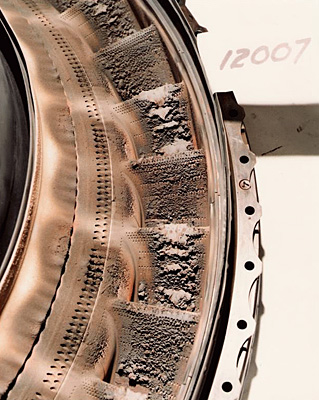The European Space Agency transmits real-time data from several satellites to a center that monitors the movement of the volcanic ash cloud created by the eruption of 60 volcanoes a year, the system will be further improved

In the photo - in June 1982, the four engines of a British Airways Boeing 747 were like this when it flew through a cloud of volcanic ash. There were 248 passengers on board. Photo: British Airways/Captain Eric Moody/European Space Agency
Thousands of planes are grounded across Europe due to the spread of volcanic ash from the eruption of the Eyjafjallajoekull volcano located under the glacier of the same name in Iceland. Volcanic eruptions release large amounts of ash and trace gases such as sulfur dioxide into the atmosphere, often reaching flight heights.
As we described yesterday, when a plane flies through the volcanic ash cloud, ash particles can enter jet engines and cause engine failure. The ash can also severely damage the fuselage, disrupt the operation of sensors, and if it hits the cockpit windows and landing lights, it will limit the pilots' visibility and jeopardize the plane's ability to land safely.
Over 90 planes were damaged after flying through volcanic ash clouds. The total cost of the damage caused by planes due to these crossings in the years 1982-2000 is estimated at 250 million US dollars.
About 60 volcanic eruptions occur each year. The monitoring systems are carried out on a limited number of them. Most volcanoes, especially those located in remote and difficult places are not monitored on a regular basis. Therefore, measuring and reporting the levels of sulfur dioxide and aerosols by satellites in real time can provide complementary information so that the possible effects of volcanic eruptions on public safety in general and air transport safety in particular can be assessed on a global level.
To improve monitoring and follow-up, the Volcanic Ash Advisory Council (VAACs) was established in 1995. Its role is to collect information about volcanic ash clouds and to help the airlines get real-time data, the European Space Agency (ESA) helps it with real-time alerts for sulfur dioxide clouds. It mainly uses the SCIAMACHY device on the Envisat satellite, and the Aura, Aqua, MetOp, OMI satellites. In addition to VAACs, the data is also transferred to those involved in volcano observations, scientific health organizations and more.
To know if an aircraft can safely pass under or over an ash cloud and to better predict the movement of the cloud, VAACs need more accurate information about the height and vertical size of the ash plume.
Moreover, the SAVAA project will provide complementary information to the alerts regarding carbon dioxide emissions from the volcanoes, from the infrared measurement devices on the satellites.
More of the topic in Hayadan:
- The eruption of the volcano in Santorini is responsible for the decline of the Minoan culture
- When the earth attacks
- The sky in the Scream painting is red because of the eruption of a volcano half a world away from Europe
- A NASA satellite photographed the emission of smoke from the eruption of Mount Athena in Sicily on October 29, 2002 at an altitude of over one hundred kilometers

8 תגובות
Herzl - The British Airways plane landed safely. At the top of the article you see a photo of one of its engines taken by the captain after landing. After all its engines went out, the plane continued its descent while descending of course. Fortunately, the plane's crew, after it was already halfway up, managed to restart the engines (I think three of them). The plane headed for a landing in Jakarta, if I remember correctly, and the crew had a visibility problem because the plane's windshields were also tinted by the volcanic ash, which made the landing difficult.
What was the end of this BA flight? Did it land or crash??
Shut down all four of his engines
Hello Yohai, I would be happy to help, in the meantime if you can point out specific faults I will fix them, but it will be after I return from the Independence Day events. Thank you.
my father
Someone already offer my father his services as an editor/corrector of spelling errors/proofreader.
It's really hard to read his articles. every time.
And it's a shame, because he writes well and interestingly.
The question of whether piston engines are less sensitive to volcanic ash, to allow aircraft with piston engines to fly, there are still several thousand old DC3 type aircraft in South America and Africa still flying.